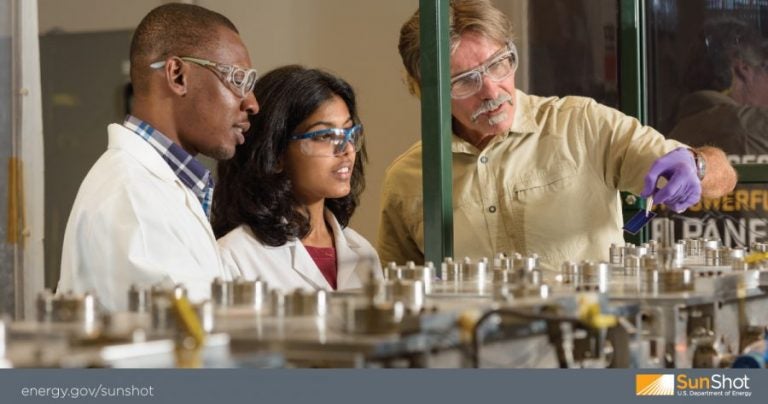A University of Central Florida-led team will receive $1.1 million to develop new manufacturing processes using a specialized tool that will bring the U.S. a step closer to achieving its goal of affordable photovoltaic (solar) energy.
The project, led by Kris Davis, a research engineer at UCF’s Florida Solar Energy Center, will largely take place at the university’s International Consortium for Advanced Manufacturing Research in Osceola County where the tool will be among the first to be installed when the building opens in spring 2017.
Making the research manufacturable was critical to getting the federal funding and having the state-of-the-art facility in Osceola County where process engineers will be on staff to manage the equipment was also imperative, Davis said.
“This is the future,” he said of the process his team will use to ultimately produce thousands of solar cells an hour in and without the costly and cumbersome vacuum-based deposition processes typically used to convert silicon wafers into solar cells.
The partnership is funded by the U.S. Department of Energy Sunshot Initiative and includes expertise provided by Germany’s Fraunhofer Institute for Solar Energy Systems (ISE) and U.S.-based manufacturer, Suniva.
The Sunshot initiative is making solar energy systems cost-competitive with other forms of energy and has a goal of driving down the cost of solar electricity to $0.06 per kilowatt hour by 2020. In many applications, like residential rooftops, solar power in in the United States is still two to three times that price point.
Davis says the challenge can only be met by both increasing efficiency and reducing manufacturing costs. His team plans to increase efficiency by incorporating metal oxide materials into silicon solar cells. The materials will result in less energy loss when the cells are created. Lower costs will be achieved by using a manufacturing process called atmospheric pressure chemical vapor deposition (APCVD) to deposit the metal oxide films.
“The ACPVD tool offers an inexpensive way to deposit metal oxide films that can make solar cells much more efficient,” Davis said. Essentially the tool eliminates the need to use expensive vacuum-based deposition equipment during the production process, instead relying on Nitrogen “gas curtains” to keep the substances separated until they combine at the silicon wafer surface, where they react to form the desired film.
Davis worked in Germany with SCHMID Group for two years developing APCVD processes and integrating APCVD films into silicon solar cells as optical coatings, passivation layers, and dopant sources. The APCVD tool is manufactured in the U.S. by SCHMID Thermal Systems, Inc., a subsidiary of SCHMID Group.
In this project, the team will use APCVD to form metal oxide materials that can act as contacts for silicon solar cells, eliminating the energy losses that can occur where metal and silicon interface. Fraunhofer ISE has demonstrated the effectiveness of these metal oxides on solar cells in a laboratory setting, and Davis said he is eager to work with Fraunhofer ISE to translate these metal oxide materials to large-scale manufacturing using APCVD. Suniva, Inc., a U.S. manufacturer of silicon solar cells and modules, will also support the effort by providing insight into the transition from lab-scale cells to high-volume manufacturing.
In three years, the team plans to have demonstrated the capability of manufacturing with the ACPVD metal oxides, setting the path for achieving the Sunshot goal.
Winston Schoenfeld, the Director of the Solar Technologies Research Division of the U.S. Photovoltaic Manufacturing Consortium (PVMC) at the Florida Solar Energy Center and a co-investigator on the project, said the new manufacturing methods they will demonstrate will have application across industries.
“We are focused on solar but many, many other applications could benefit. At ICAMR we will have exposure to markets we don’t even know about,” he said.
Chester Kennedy, ICAMR CEO, said the project is an example of the type of federal funding ICAMR was established to attract.
“Having this facility in Osceola makes the Central Florida region competitive in ways we could only have imagined before,” he said.
